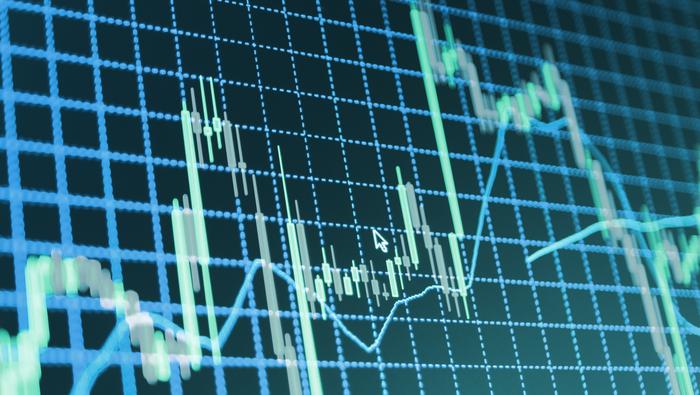How To Use Twitter For Traders
- Trade The News
- The Role of Twitter
- When Did Twitter Become Important For Traders
- Examples: Twitter Ahead of Traditional Newswires
- How to Spot Fake News
- How Traders Effectively Monitor Twitter
- Who to Follow on Twitter
TWITTER TRADERS
Since the introduction of social media, the 21st century trader has had a new tool at their disposal. In this article, I will discuss how financial market participants can utilise social media, with a particular focus on Twitter as a key resource to track vital market-moving macro news. I will go through notable examples I have seen in recent years where social media has provided an edge for traders, alongside a helpful insight on how to use social media efficiently and spot fake news!
Before going any further, I would like to state that I will not be providing any insight into the Reddit retail trading army of WallStreetBets, mainly on the premise that I haven’t used the blog myself (and don’t intend to). So for those looking for the Reddit trading 101 guide, this is not the report for you.
TRADE THE NEWS
An area that has been covered extensively by DailyFX is “trading global macro news”, which ties in quite nicely with how you can approach social media for analysing financial markets. Therefore, it is important that at first, you have a firm understanding of the fundamental drivers for the assets that you trade and are also constantly up-to-date with the current themes/narratives. With this knowledge of key market drivers, alongside current market positioning/sentiment, as a trader, this will better prepare you as to how markets will react to new information. Keep in mind that the current price of an asset reflects all available information (or so it should, according to the Efficient Market Hypothesis). Subsequently, whenever new information is released, whether that be economic data or central bank rate decisions, the price of an asset will typically move to find a new price, which reflects that information.
However, there is an argument that a lot of macro news is simply noise and does not have a significant impact on the assets you trade, and I do sympathise with that view to an extent. When incoming newsflow is flashing on your screen, you can break it down by asking two questions:
- Is this information new and if so, does it deviate from the market narrative (consensus/expectations)
- Is this information noteworthy
If your answer to both questions is ‘no’, then you can say with good authority that the new information is not market moving. I appreciate that this is a skill that will not be mastered immediately, and quite frankly may never be completely mastered. As is usually the case with anything you do in life, experience over time is what counts, which will go a long way in helping you digest key macro newsflow efficiently.
As I mentioned above, DailyFX has covered this topic in great detail, so for a complete comprehensive guide on trading the news, click on the link below.



THE ROLE OF TWITTER
Whether you’re a millennial on TikTok hoping to become the next viral sensation or someone who scrolls endlessly through Instagram, social media has fundamentally changed the way that we interact with each other and disseminate new information. Since the creation of Twitter in 2006, the micro-blogging platform has seen its user base grow significantly, becoming arenowned source of breaking news, updated instantly by those who are closest to the event, ranging from journalists, government officials, company executives or even a bored multi-billionaire, looking at you, Elon (who may end up owning the platform.)
Twitter in numbers:
- Monthly Active Users: 330mln
- Daily Number of Tweets: 500mln
WHEN DID TWITTER BECOME IMPORTANT FOR TRADERS
AP “Fake” Tweet (April 23rd, 2013) | DJIA -1% in Minutes Before Retracing
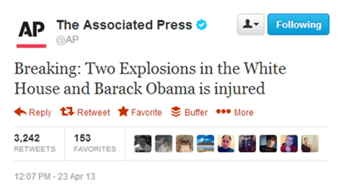

Source: Bloomberg
For me, this is a tough one to pinpoint, given that I have only been in markets since 2014. Although looking back, a key moment that provided a stark look at Twitter’s growing importance on financial markets came after the “hack crash” in 2013. According to The Associated Press, a false message stated that there had been two explosions at the White House with the President at the time, Barack Obama, being injured. This saw around $130bln temporarily wiped from US indices before retracing in a matter of minutes. Shortly after the false tweet, the White House Spokesman noted that the President was fine, while AP later stated that they had been hacked. Consequently, with the impact seen by all, that a tweet can have on financial markets, this had sped up the process of traders adopting Twitter as a means for monitoring breaking news. However, this example also highlights the fact that Twitter is an unfiltered newswire where the authenticity of news can often come into question, which I will delve into later in this report.
EXAMPLES: TWITTER AHEAD OF TRADITIONAL NEWSWIRES
Over the years and more recently given notable political events, namely Brexit and US-China Trade Wars, there have been numerous occasions where Twitter has been quicker to report breaking macro and company news than traditional newswires (Bloomberg and Refintiv). When this occurs, I judge this as providing traders with an edge over the market. What I mean by the market is algo’s trading off Bloomberg and Refinitiv headlines. But to save column inches I will go through a few noteworthy examples where Twitter has provided an edge.
CASE STUDY 1: OIL MARKET, APRIL 2020
Oil prices had collapsed as traders responded to the onset of the coronavirus crisis with the first wave of global lockdowns prompting oil demand to plunge by 1/3. Matters had been made worse for the oil market with oil plummeting to an 18-year low after Russia and Saudi Arabia had engaged in a price war.
On April 2nd, 2020 at 15:30GMT, CNBC published the tweet below. In the following 42 seconds, Bloomberg had published the original tweet, while a flashing red BBG headline occurred at 15:34.49. Refinitiv on the other hand had run the full tweet at 15:32.39. In an 8-minute period from Tweet to peak, Brent crude oil rose over 37%.
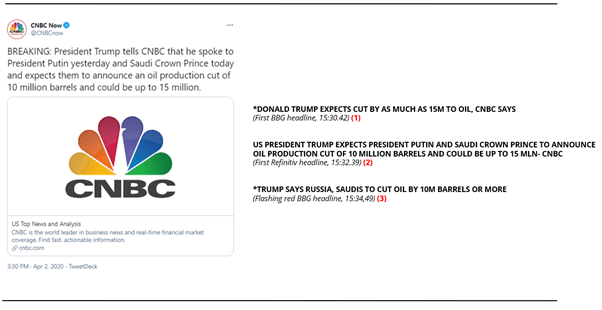
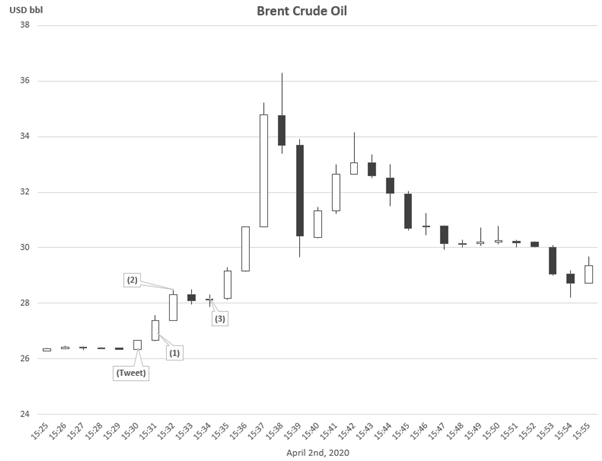
Source: ICE, DailyFX
CASE STUDY 2: TRADE WAR, AUGUST 2019
In the tradition of politics in the age of social media, market participants had grown accustomed to monitoring Former US President Donald Trump’s Twitter account for market-moving political announcements, which largely centred around trade wars with China.
On August 1st, 2019, US President Trump escalated trade war tensions with China by announcing that the US will put on 10% tariffs on $300bln worth of Chinese products. Prior to the tweet hitting traditional newswires, USD/JPY fell from 108.14 to 108.00, while the subsequent move after Bloomberg reported the tweet saw USD/JPY extend its move lower to hit a low of 107.26 in the following 30-minutes.


Source: Bloomberg, DailyFX
CASE STUDY 3. BREXIT, OCTOBER 2020
During the Brexit saga, the first point of communication for many political correspondents had been via Twitter. This meant that traders who followed high ranking journalists that typically received the latest scoop from the halls of Westminster had a speed advantage over BBG/Refinitiv owners. The example below shows one of many occasions where Twitter had been quicker to report breaking Brexit news. Of course, the risk was the authenticity/reliability of the headlines, however, this was largely dependent on the journalist who tweeted the report.
On October 1st, 2020, a political correspondent tweeted that the probability of a Brexit deal had shifted from 30% to 70%. As such, in the near 4-minutes before the tweet crossed the wires (Refinitiv), GBP/USD rose from 1.2841 to 1.2871 before taking a fresh leg higher from 1.2871 to 1.2976 in 36-minutes after the tweet had been picked up by Refinitiv.

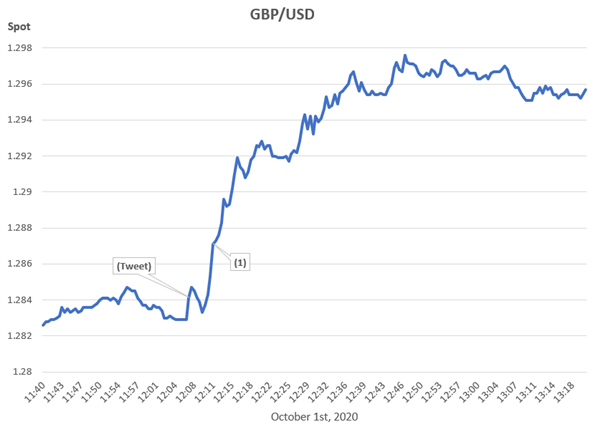
Source: Bloomberg
HOW TO SPOT “FAKE NEWS”
The one obvious drawback to Twitter is the spread of misinformation or as Donald Trump likes to say, “fake news”. Newsflow across Twitter is typically less credible than more traditional news sources (WSJ, Sky News, BBC, CNBC). However, there are several steps you can take to help identify fake news:
- Is the account verified, in other words, does the account have a blue tick? If so, this increases the authenticity of that account’s tweets.
- Following/follower ratio. An account providing news will typically have a low following account relative to followers.
- Erroneous spelling in the profile name and bio is common for fake accounts, particularly those that impersonate other accounts with letters replaced with numbers (“O” and “0”).
- Twitter join date. A fake account is typically on Twitter for a short period of time as they tend to be suspended rather quickly. This also ties into the number of tweets, which are considerably lower in fake accounts than official news accounts that tweet 24/7.
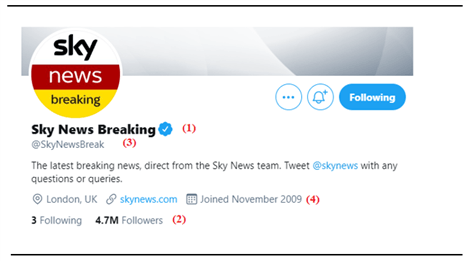
HOW CAN TRADERS EFFECTIVELY MONITOR TWITTER
An efficient way to monitor macro news on Twitter is via using tools such as Tweetdeck. This allows users to filter out noise and focus on the news relevant to the assets that they trade. What’s more, Tweetdeck provides an effective way to stay on top of breaking news, which is important for global macro-based traders who trade on a short-term horizon. The most delightful part about Tweetdeck is that it is free to use, all you need is a Twitter account.
As shown in the image below, Tweetdeck can be monitored via columns using customised lists, making the platform an efficient news streamer to spot breaking news quickly.
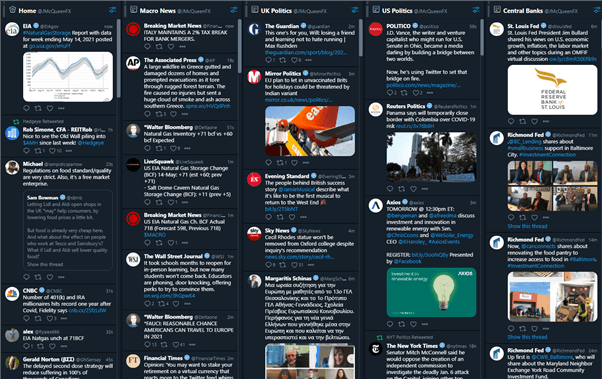
Source: Tweetdeck
WHO TO FOLLOW ON TWITTER
Network: Follow who is in your network that adds value and by value I mean, forward-looking insightful commentary. You can even ask the question, who are the top macro/FX, Commodity, equity analysts to follow on Twitter.
Create a list and separate them by topic (important for Tweetdeck): As I mentioned above, creating your own curated lists can help you sift through the noise. But remember, update your lists frequently as the market narrative shifts.
- Fast News Outlets, UK Politics, #OOTT (Organisation of Oil Traders on Twitter)
Cut Out the Noise: Now while there are plenty of experienced and intelligent people on Twitter, there is also a lot of noise, stemming from the likes of permabears. Avoid them, as it is very rarely time well spent. Someone who has warned of a looming market crash and suggested to long gold for several years is not helpful for your trading. Don’t believe me, just pop open a chart of gold and the S&P 500 over the past decade.


